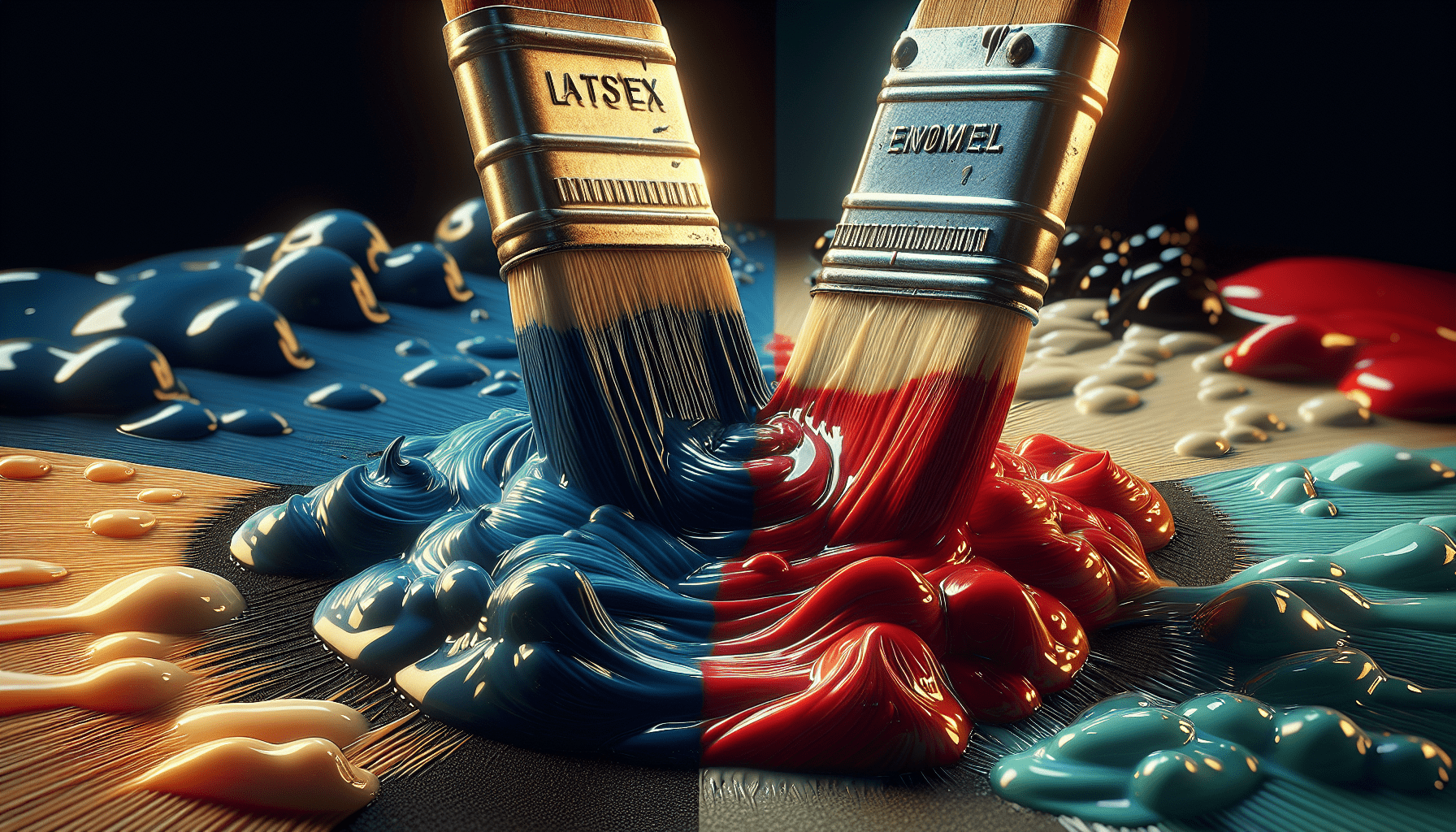Polyurethane, a clear protective finish, is often used to provide a durable and glossy coating on various surfaces. However, when it comes to applying polyurethane over latex paint, there seems to be some confusion and uncertainty. Many wonder whether it is even possible to do so without compromising the quality of the finish. In this article, we will explore the compatibility of polyurethane with latex paint and shed light on the factors to consider when contemplating this application. By understanding the considerations and following the proper steps, you can achieve a seamless and long-lasting result for your painted surfaces.

What is polyurethane?
Definition of polyurethane
Polyurethane is a versatile polymer made from a combination of isocyanates and polyols. It is known for its strong and durable properties, which make it suitable for a wide range of applications. Polyurethane can be found in various forms, such as foam, adhesives, sealants, and coatings.
Common uses of polyurethane
Polyurethane is commonly used as a protective coating for surfaces such as floors, furniture, and cabinets. It provides a hard and glossy finish that enhances the appearance of the underlying material while also offering protection against scratches, stains, and moisture. Polyurethane is also used in the automotive industry for applications such as car interiors and exteriors.
What is latex paint?
Definition of latex paint
Latex paint, also known as acrylic paint, is a water-based paint that contains acrylic resins. It is widely used for interior and exterior wall surfaces due to its ease of application, quick drying time, and low odor. Latex paint is available in a wide range of colors and finishes, making it a popular choice for both professional painters and DIY enthusiasts.
Advantages and disadvantages of latex paint
Latex paint offers several advantages over other types of paint. It is non-toxic and environmentally friendly, as it does not contain harmful solvents. Latex paint is also easier to clean up, as it can be washed off with soap and water. Additionally, it has good durability and resistance to mildew.
However, latex paint may not be as durable as other types of paint, such as oil-based paint. It can be susceptible to chipping and peeling, especially in high-traffic areas or when exposed to harsh conditions. Latex paint may also have a lower level of sheen compared to oil-based paint, which can affect the overall aesthetic appearance.
Can you apply polyurethane over latex paint?
Compatibility
Polyurethane and latex paint can be applied together in certain circumstances. However, it is important to ensure compatibility between the two coatings to achieve a successful result.
Preparation required
Before applying polyurethane over latex paint, proper preparation is crucial. This includes cleaning the surface, sanding and priming if necessary, and testing the compatibility between the two coatings.
Compatibility
Polyurethane and latex paint properties
Polyurethane and latex paint have different properties that can affect their compatibility. Polyurethane is a solvent-based coating that forms a strong and durable film when applied. On the other hand, latex paint is water-based and dries to form a flexible and breathable film.
Adhesion between different coatings
Ensuring good adhesion between polyurethane and latex paint is essential for a long-lasting finish. Both coatings should be compatible and properly bonded to the surface to prevent peeling or flaking. Testing the adhesion by applying a small amount of polyurethane over a cured latex paint sample is recommended before proceeding with the full application.
Potential issues when combining polyurethane and latex paint
Combining polyurethane and latex paint can sometimes lead to compatibility issues. If the latex paint contains certain additives or pigments, it may react with the polyurethane and cause discoloration or other undesirable effects. It is important to test a small inconspicuous area before applying polyurethane over a larger surface.

Preparation required
Cleaning the surface
Before applying polyurethane over latex paint, it is important to ensure that the surface is clean and free from any dirt, grease, or contaminants. Thoroughly clean the surface using a mild detergent and water, then rinse it off and allow it to dry completely.
Sanding and priming
In some cases, sanding and priming may be necessary to improve adhesion between the two coatings. Lightly sand the latex paint surface to create a rough texture, then wipe away any dust. Apply a suitable primer that is compatible with both the latex paint and the polyurethane.
Testing the compatibility
To ensure compatibility between polyurethane and latex paint, it is advisable to perform a small test area before applying the polyurethane over the entire surface. Apply a small amount of polyurethane over a cured latex paint sample and observe for any adverse reactions, such as discoloration or peeling.
Process of applying polyurethane over latex paint
Gather materials
Before starting the application process, gather all the necessary materials. This includes polyurethane, a high-quality brush or applicator, paint tray, sandpaper, primer (if needed), and protective equipment such as gloves and goggles.
Prepare the work area
Prepare the work area by removing any furniture or objects that could interfere with the application process. Cover the surrounding surfaces with drop cloths or plastic sheets to protect them from any drips or spills.
Apply polyurethane
Dip the brush or applicator into the polyurethane and remove any excess by tapping it against the side of the paint tray. Apply a thin, even coat of polyurethane over the latex paint surface, working in the direction of the grain if applicable.
Allow for drying and curing
Allow the polyurethane to dry according to the manufacturer’s instructions. This usually takes a few hours, but it is important to allow sufficient drying time between coats to ensure proper adhesion and durability. After the initial coat is dry, lightly sand the surface and remove any dust before applying additional coats if desired.
Apply additional coats if desired
If a higher level of protection or sheen is desired, apply additional coats of polyurethane following the same process. Each coat should be sanded and dusted before applying the next. Multiple thin coats will provide better results compared to a single thick coat.
Tips for a successful application
Choose the right type of polyurethane
There are different types of polyurethane available, such as oil-based and water-based. It is important to choose the right type for your specific project. Water-based polyurethane is generally more compatible with latex paint, but always check the manufacturer’s recommendations for the best results.
Check for compatibility
Before applying polyurethane over latex paint, it is crucial to test for compatibility. As mentioned earlier, apply a small amount of polyurethane over a cured latex paint sample and observe for any adverse reactions. This will help determine if the two coatings are compatible and will give you an idea of the final result.
Apply thin coats
When applying polyurethane over latex paint, it is best to apply thin coats rather than thick ones. Thin coats dry faster and allow for better adhesion between the two coatings. It also helps prevent the formation of bubbles or uneven drying.
Avoid excessive brushing or rolling
Excessive brushing or rolling can create brush marks or streaks in the polyurethane finish. To avoid this, apply the polyurethane in long, smooth strokes and do not overwork the coating. This will help achieve a smooth and even finish.
Ensure proper ventilation
Polyurethane can emit strong fumes during the application and curing process. It is important to ensure proper ventilation in your work area by opening windows or using fans. This will help dissipate the fumes and create a healthier environment.
Frequently asked questions
Can you polyurethane over wet latex paint?
No, it is not recommended to apply polyurethane over wet latex paint. The latex paint needs to be completely dry and cured before applying the polyurethane. Applying polyurethane over wet paint can result in poor adhesion and a compromised finish.
Can you polyurethane over oil-based paint?
Yes, polyurethane can be applied over oil-based paint. However, proper surface preparation is essential to ensure good adhesion. The oil-based paint should be clean, dry, and cured before applying the polyurethane. Sanding the surface lightly and applying a primer may also be necessary for optimal results.
Can you polyurethane over chalk paint?
Yes, polyurethane can be applied over chalk paint. Chalk paint is a porous finish, so applying a layer of polyurethane can help seal and protect the surface. Lightly sanding the chalk paint and removing any dust before applying the polyurethane is recommended to ensure proper adhesion.
Conclusion
Before applying polyurethane over latex paint, it is important to consider several factors, including compatibility between the two coatings and proper preparation techniques. Polyurethane can be successfully applied over latex paint, but it requires careful planning and execution. Following the steps outlined in this article will help ensure a successful application and a durable finish.
Additional resources
For more information on polyurethane application and recommended products, please refer to the following resources:
- [Link to polyurethane application guide 1]
- [Link to polyurethane application guide 2]
- [Link to recommended polyurethane products]



